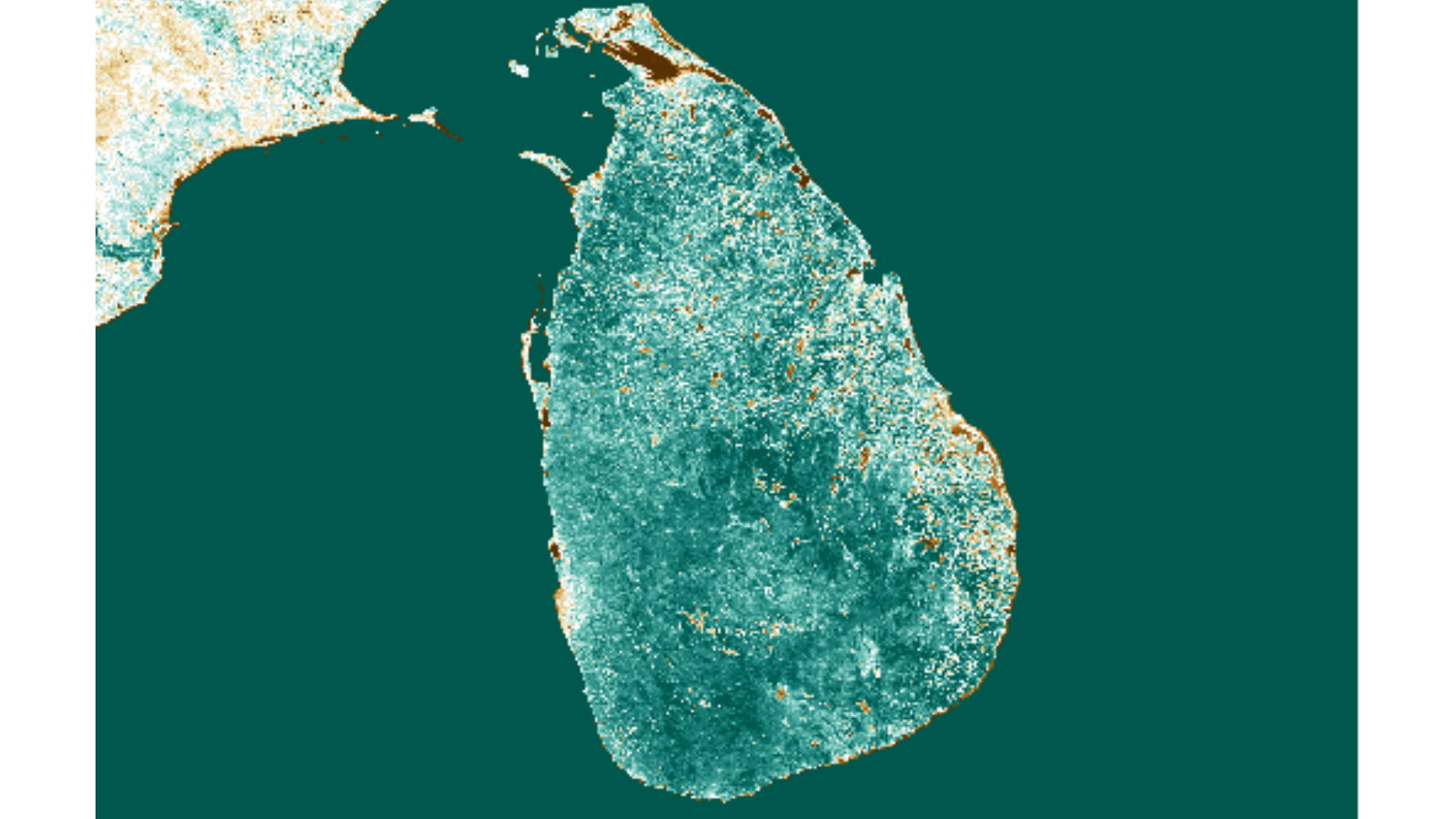
Sri Lanka, this island state located in the south-east of India, contains an incredible biodiversity due to the diversity of the natural environments it shelters, such as the Sinharaja Reserve. Its specific geographical location on a geological fault and its humid tropical climate make it an ideal environment for numerous endemic species such as the Sri Lankan elephant, which live in the midst of lush green flora.
Relative to its small size, the island has a remarkable diversity of forests with one of the highest biodiversity concentration indices in the world (2.17 BioD index). These are distributed as follows: 70% dry tropical monsoon forest cover, 15% tropical rainforest and 5% low relief tropical montane forest. Covering more than 15,500 km 2 , the forests are distributed through local policies through several dozen protected nature reserves. These generate significant flows of tourism representing nearly 10% of the country’s GDP. The attraction of the encounter with sacred places, the population and this local biodiversity has indeed generated, in a pandemic context in 2020, the arrival of 540,000 tourists.
Affected by this massive influx of tourists, the country has in recent years embraced the transition to more ethical and sustainable tourism. This has led many key players in the industry to rethink their approach to travel. Initiatives such as the Eductours now offer both Sri Lankan professionals and international agencies the opportunity to discover concrete positive initiatives and to amplify synergies towards the tourism of tomorrow.
On the occasion of the Eductour organised by Flockeo with 4 agencies in Sri Lanka within its network during the first week of May 2022, we wanted to re-examine the situation of protected areas in Sri Lanka through the prism of the tourism issue. To do so, we once again used satellite data analysis to understand the anthropogenic impacts on ecosystems.
We then focused on the Sinharaja Reserve, located in the southwest of Sri Lanka. We studied the evolution of its biodiversity and analysed the importance of the existence of such a protected natural reserve through the carbon sequestration of this forest.
Sri Lanka has a unique flora and fauna, which benefits from an island with vast, unspoilt natural areas.
Sri Lanka’s forests are made up of 60% of the island’s endemic trees, with a further 50% of endemic mammals. There are also unique butterflies, insects, reptiles and amphibians that are found only in Sri Lanka.
The importance of natural areas and biodiversity in Sri Lanka is very high. These areas still cover a major part of the island. This is even more striking when the island is viewed from space using satellite data.
Using the land use indicator, the forest and green dimension of the island is fully apparent.

(Land Cover Indicator Map of Sri Lanka, 2020, ©Murmuration)
First of all, we can see that most of the island is covered by trees (in green). It can also be seen that arable land covers a significant part of the eastern part of the country. Finally, the land use indicator highlights the presence of urban areas (in red), the most important being Colombo in the west of the country.
The Sinharaja Reserve has been a UNESCO World Heritage Site since 1989. It is considered the last viable area of primary rainforest in Sri Lanka. It covers more than 8,000 hectares, in the heart of an already heavily forested region.

(Land Cover Indicator of the Reserve of Sinharaja, Sri Lanka, 2020, ©Murmuration)
This forest is very little altered (exclusively green area), which proves the necessity of protecting these green areas and the positive results of this protection. It is clearly visible from space that this area is almost untouched by urban construction or agricultural cultivation.
This is due in part to the status of this biodiversity area as a UNESCO World Heritage Site. It also benefits from real protection by the Sri Lankan public services. Finally, it also benefits historically from the lack of road access to the reserve.
We are therefore in the presence of an authentic primary forest, i.e. a forest composed of indigenous species where no trace of past or present human activity is clearly visible.
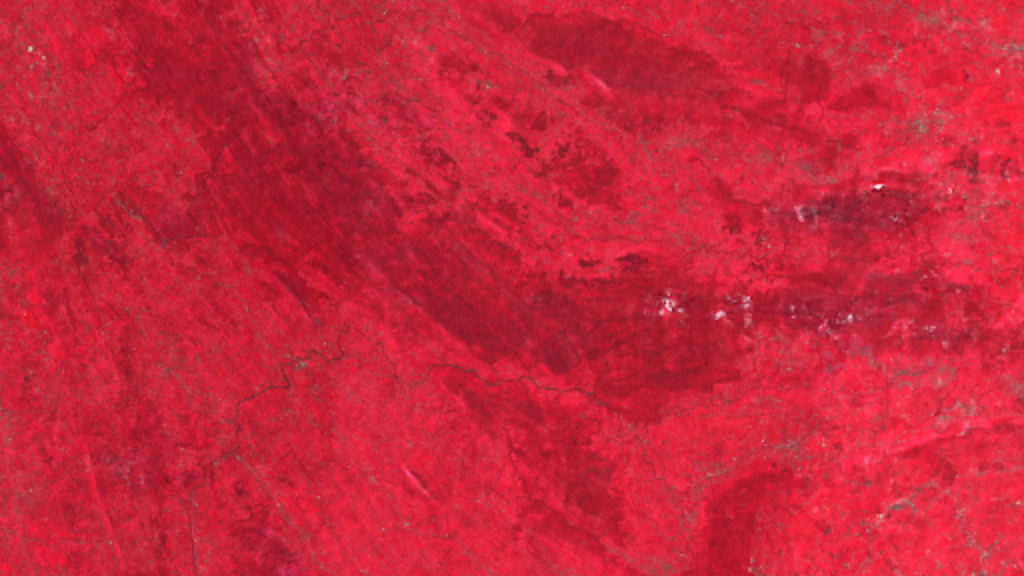
(Vegetal Cover Indicator Map of the Reserve of Sinharaja, Sri Lanka, 2020, ©Murmuration)
Focusing on the vegetation cover of the area, the Sinharaja Reserve (center, in darker red) can be clearly seen. The darker is the red, the more vegetation is present on the land.
However, as highlighted in this article, establishing the health and sustainability of a forest is not usually based solely on its vegetation density.
To monitor the biodiversity of the Sinharaja reserve, we used our vegetation health indicator, obtained by calculating the NDVI (Normalized Difference Vegetation Index). Based on spatial Earth observation data, it allows us to assess the content and evolution of vegetation in a territory.
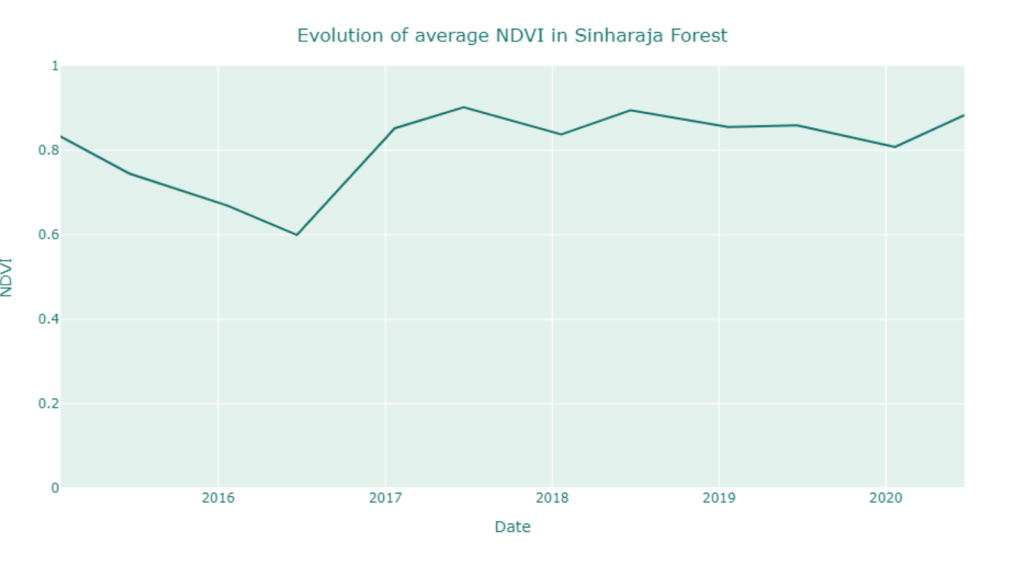
(Evolution of the Average NDVI in Sinharaja Reserve, 2 samples a year, 2015-2020, ©Murmuration)
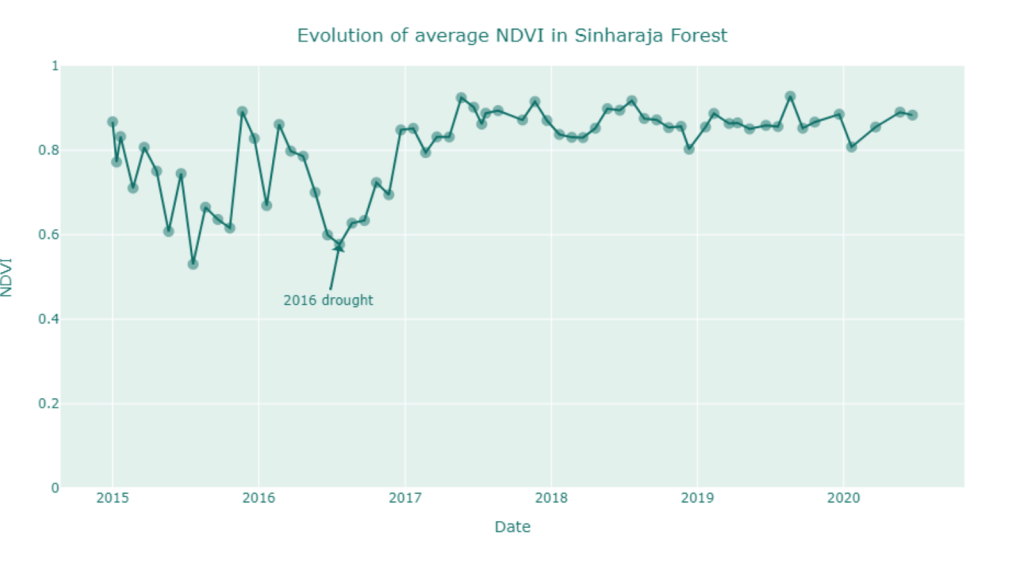
(Evolution of the Average NDVI in Sinharaja Reserve, 1 sample every month, 2015-2020, ©Murmuration)
The graphs above show the evolution of the average health of the vegetation from 2015 to 2020.
Two phenomena should be highlighted:
The use of this vegetation health indicator allows the state of the green spaces to be quantified precisely and comprehensively. However, it is important to emphasise that indicators here are 6-month and 1-month average of a natural phenomenon that is constantly changing. In addition, there are many climatic, environmental and anthropogenic phenomena that influence the health of the vegetation.
In Sri Lanka, biodiversity is notably subject to two monsoon seasons: Yala and Maha. Yala takes place in the southwestern part of the island from May to July. This is the great monsoon, creating a very humid climate.
Maha, is the second monsoon period, on the North East coast of Sri Lanka. It usually occurs from October to January.
These two periods play an essential role in the development and preservation of Sri Lanka’s biodiversity.
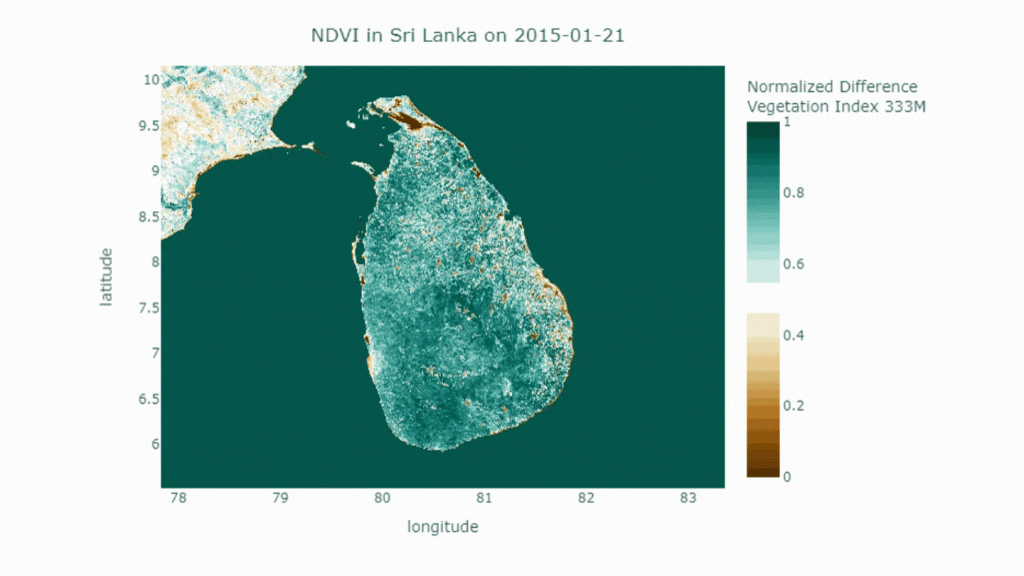
(NDVI Map of Sri Lanka, 2015- 2020, ©Murmuration)
This systematic evolution of biodiversity is visible from space, by observing the vegetation health indicator during the different seasons and over several years (2015-2020).
Real variations can be seen: biodiversity evolves, moves, clusters and expands with each monsoon.
Therefore, climate change plays an important role in the evolution of Sri Lanka’s biodiversity. The lack of monsoons, or the reduction of rainy days are real factors that threaten Sri Lanka’s biodiversity.
Biodiversity must be protected at all costs, as its role is crucial in the fight against carbon and climate change.
We have previously highlighted the fact that the Sinharaja reserve is a primary rainforest. This is of particular importance for understanding the role of biodiversity in the fight against climate change.
Our carbon sequestration indicator allows us to highlight the role that a primary forest such as Sinharaja plays in this phenomenon.

(Carbon Sequestration Indicator Map of Sinharaja Reserve, 2020, ©Murmuration)
This indicator makes it possible to determine the quantity of carbon sequestered by the reserve, in this case 1 million tonnes of CO2 sequestered per hectare. The reserve is clearly visible in this image.
The green colour represents the areas sequestering carbon, the more intense the colour, the greater the quantity of carbon sequestered. In contrast, grey represents areas where little carbon is sequestered.
To put it another way, the forest of the Sinharaja reserve alone retains nearly 9 billion tonnes of carbon. By comparison, the annual carbon output of global aviation is approximately 660 million tonnes of CO2/year.
If this figure seems so high, it is essentially due to the age and preservation of this area of biodiversity. Virtually untouched by human disturbance, the forest has been able to accumulate a gigantic amount of carbon from its birth to the present day.
The forest absorbs carbon from the air and transforms it into branches, leaves and all forms of vegetation. In doing so, the forest absorbs CO2, retains the carbon for its development and releases O2 into the air. This phenomenon, called photosynthesis, is the source of carbon capture by forests.
It is therefore important to emphasise that the Sinharaja reserve does not consume nearly 9 billion tonnes of carbon per year, no, it is made up of carbon!
This forest has absorbed all this carbon since the beginning of its existence (which can represent several thousands or even millions of years), but it does not disappear, it is present in the wood of the trees.
In the course of these analyses of biodiversity in Sri Lanka, and in particular vegetation, several threats to the Sri Lankan environment are observed.
Firstly, the ultimate need to protect the Sinharaja reserve, in order to avoid any release of carbon into the atmosphere. This is already very difficult to control today, and any further release is a step backwards in the fight against climate change.
The territorial protection of the reserve is of great importance as it is subject to many pressures, be they urban, economic and/or social.
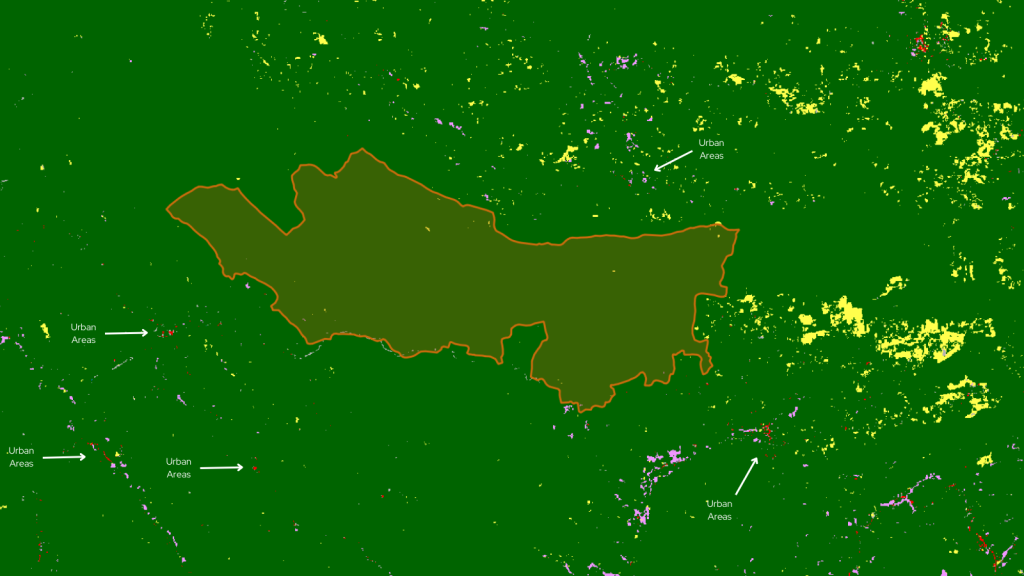
(Land Cover Indicator Map around the Sinharaja Reserve, Sri Lanka, 2020, ©Murmuration)
The reserve is confronted with urban pressure and the phenomenon known as “urban sprawl”. Indeed, towns are taking up more and more land and people are settling ever closer to natural areas. As can be seen in this map, some small towns are not far from the reserve and are already taking land from the forest around them.
In order to meet human needs for access to work and health care, Sri Lanka has built new roads, which are coming dangerously close to the Sinharaja reserve, and in some cases already threaten the reserve.
These roads are being built to give residents easier access to services that are only available in the larger towns.
Although the construction of this road is motivated by important human needs/necessities, it is important to measure its immediate impact on nature, but also those to come, which are also called negative externalities.
Indeed, the construction of a road will not only have environmental consequences of the construction, but also of the use of the road. We are talking here about the traffic to which these roads will be subjected, and therefore the penetration of polluting vehicles as close as possible to the nature reserve.
Finally, these roads can also be diverted from their basic principle and used for profoundly anti-environmental economic purposes. The opening of such roads increases the number of access points to the forest and thus facilitates access to illegal exploitation of the forest and illegal resource extraction.
To combat these negative externalities, several solutions can be envisaged.
Firstly, constant monitoring of the forest (in particular through the use of satellites). Secondly, increased funding for the protection of the integrity of the forest, including the addition of staff to monitor and punish infractions.
The financial contribution of tourism, attracted by this reserve, can and should be a source of funding for the protection of Sri Lanka’s biodiversity.

(Comparison of NDVI in the Sinharaja Reserve , in January and June, 2015-2020, ©Murmuration)
As can be seen from these images, the vegetation cover came to a considerable halt in 2016.
This year was known to be one of the driest on record. The major consequence of this drought, which can be seen regardless of the season, was the regression of the vegetation space in the reserve.
This phenomenon has been observed in several places around the world. It shows the extreme vulnerability of plant areas to climate change.
This environmental phenomenon raises a series of questions concerning the struggle of state and social actors against international and climatic phenomena.
In addition, such events underline the importance of the need for a global effort to combat global warming, which directly threatens the world’s biodiversity, our forests, our oceans, and consequently the air we breathe.
The protection of the biodiversity is now more than ever a major concern of human’s health and future.
Sources : Copernicus Programm
Authors : Maël Plantec, Camille Lainé, Muruguesh Manthiramoorthi, Fabien Castel, Rémi Nassiri